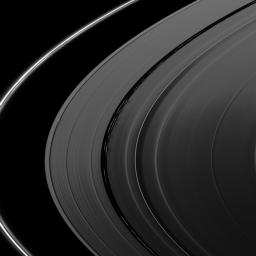
|
Shadows and More Shadows
- Click the image above for a larger view
- Full-Res JPEG (1020 x 1020) (59.6 kB)
- Full-Res TIFF (1020 x 1020) (1.0 MB)
Caption:
Several sets of shadows are cast onto the A ring in this image taken about a week after Saturn's August 2009 equinox.
Near the middle of the image, shadows are cast by vertically extended clumps in the kinky, discontinuous ringlets of the Encke Gap in the A ring. These clumps are casting shadows approximately 275 kilometers (170 miles) long, implying a clump height about 600 meters (2,000 feet) above the ring plane.
In the middle left of the image, the waves created by Daphnis (8 kilometers, 5 miles across) on the edge of the Keeler Gap cast shadows on the A ring that are about 450 kilometers (280 miles) long, indicating waves that rise about one kilometer above the ring plane. The moon itself is not visible at this resolution, but it, too, orbits in the Keeler Gap of the A ring. Daphnis has an inclined orbit, and its gravitational pull perturbs the orbits of the particles of the A ring forming the Keeler Gap's edge and sculpts the edge into waves having both horizontal (radial) and out-of-plane components. Material on the inner edge of the gap orbits faster than the moon so that the waves there lead the moon in its orbit. Material on the outer edge moves slower than the moon, so waves there trail the moon. See PIA11654 to learn more.
Elsewhere, bending (or vertical) waves in the rings that spiral all the way around the rings and are generated by external Saturnian satellites are also casting shadows. The bright "ringlet" passing through the center of the image is the Mimas 5:3 bending wave, accompanied by a broad and azimuthally extended dark band of shadow. To the right of this feature is the Mimas 7:4 bending wave -- another, narrower bending wave feature with its shadow band. On the left of the image, the dark band between the Encke and Keeler Gaps, a bit closer to the latter, is the shadow created by the 8:5 Mimas bending wave. See PIA10501 to learn more.
The novel illumination geometry that accompanies equinox lowers the sun's angle to the ring plane, significantly darkens the rings, and causes out-of-plane structures to look anomalously bright and cast shadows across the rings. These scenes are possible only during the few months before and after Saturn's equinox which occurs only once in about 15 Earth years. Before and after equinox, Cassini's cameras have spotted not only the predictable shadows of some of Saturn's moons (see PIA11657 ), but also the shadows of newly revealed vertical structures in the rings themselves (e.g., see PIA11665 ).
This view looks toward the sunlit side of the rings from about 11 degrees above the ring plane.
The image was taken in visible light with the Cassini spacecraft narrow-angle camera on Aug. 19, 2009. The view was obtained at a distance of approximately 2.3 million kilometers (1.4 million miles) from Saturn and at a Sun-Saturn-spacecraft, or phase, angle of 116 degrees. Image scale is 13 kilometers (8 miles) per pixel.
Background Info:
The Cassini-Huygens mission is a cooperative project of NASA, the European Space Agency and the Italian Space Agency. The Jet Propulsion Laboratory, a division of the California Institute of Technology in Pasadena, manages the mission for NASA's Science Mission Directorate, Washington, D.C. The Cassini orbiter and its two onboard cameras were designed, developed and assembled at JPL. The imaging operations center is based at the Space Science Institute in Boulder, Colo.
For more information about the Cassini-Huygens mission visit http://saturn.jpl.nasa.gov/ . The Cassini imaging team homepage is at http://ciclops.org .
Cataloging Keywords:
| Name | Value | Additional Values |
|---|---|---|
| Target | Saturn Rings | A Ring, Daphnis, Encke Gap, Mimas, Saturn |
| System | Saturn | |
| Target Type | Ring | Gap, Planet, Satellite |
| Mission | Cassini-Huygens | |
| Instrument Host | Cassini Orbiter | |
| Host Type | Orbiter | |
| Instrument | Imaging Science Subsystem (ISS) | |
| Detector | Narrow Angle Camera | |
| Extra Keywords | Clump, Grayscale, Shadow, Visual, Wave | |
| Acquisition Date | ||
| Release Date | 2009-09-21 | |
| Date in Caption | 2009-08-19 | |
| Image Credit | NASA/JPL/Space Science Institute | |
| Source | photojournal.jpl.nasa.gov/catalog/PIA11676 | |
| Identifier | PIA11676 | |
